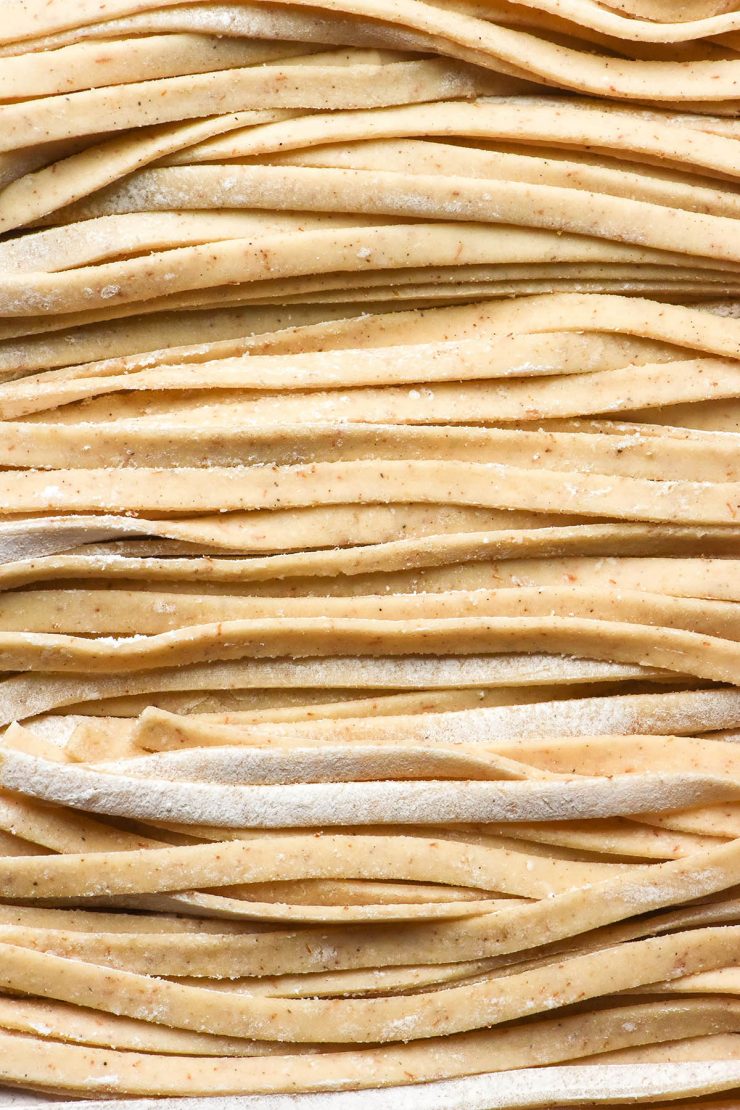
Summer is slowly drawing to a close here in Australia and I wanted to get the jump on some Autumnal comfort foods. Pasta is my number one when it comes to comfort, so I was eager to develop this recipe for gluten free egg pasta without xanthan gum.
Gluten free egg pasta without xanthan gum
This gluten free egg pasta is one of my favourite new ways to cook without xanthan gum. While xanthan gum isn’t inherently bad, it does irritate a lot of people with digestive issues. Given that it is in every single thing in the gluten free aisle, I try to develop my recipes without it. Hopefully people like me who don’t tolerate xanthan gum find them useful.
Anyway, back to the pasta! This pasta is made with white rice flour and tapioca flour. These flours are easy to acquire, inexpensive and have a neutral flavour. With that said, I will go into some substitution options below.
So how does the pasta hold together, you might ask? With the help of three things: psyllium husk powder, eggs and a scald. Combined, these work together to create a sturdy pasta dough that is easy to roll out and holds together as it cooks. A gluten free miracle!

What is a scald?
Scalding flour is simply the process of adding boiling water to the flour. The boiling water gelatinises the flour, creating elasticity. A scald is incredibly useful in gluten free baking, because gluten free wholegrain flours (buckwheat excluded) have no inherent elasticity in the absence of gluten.
Because this is an egg based pasta, the scald must be separate to the addition of eggs. Boiling water and eggs don’t mix well, after all (unless you plan to poach them).
As such, the dough is partially scalded and left to cool prior to adding the eggs. This gives us the best of all worlds: scalded flour, activated psyllium husk powder (which gels up faster with hot water) and the binding power of the eggs.
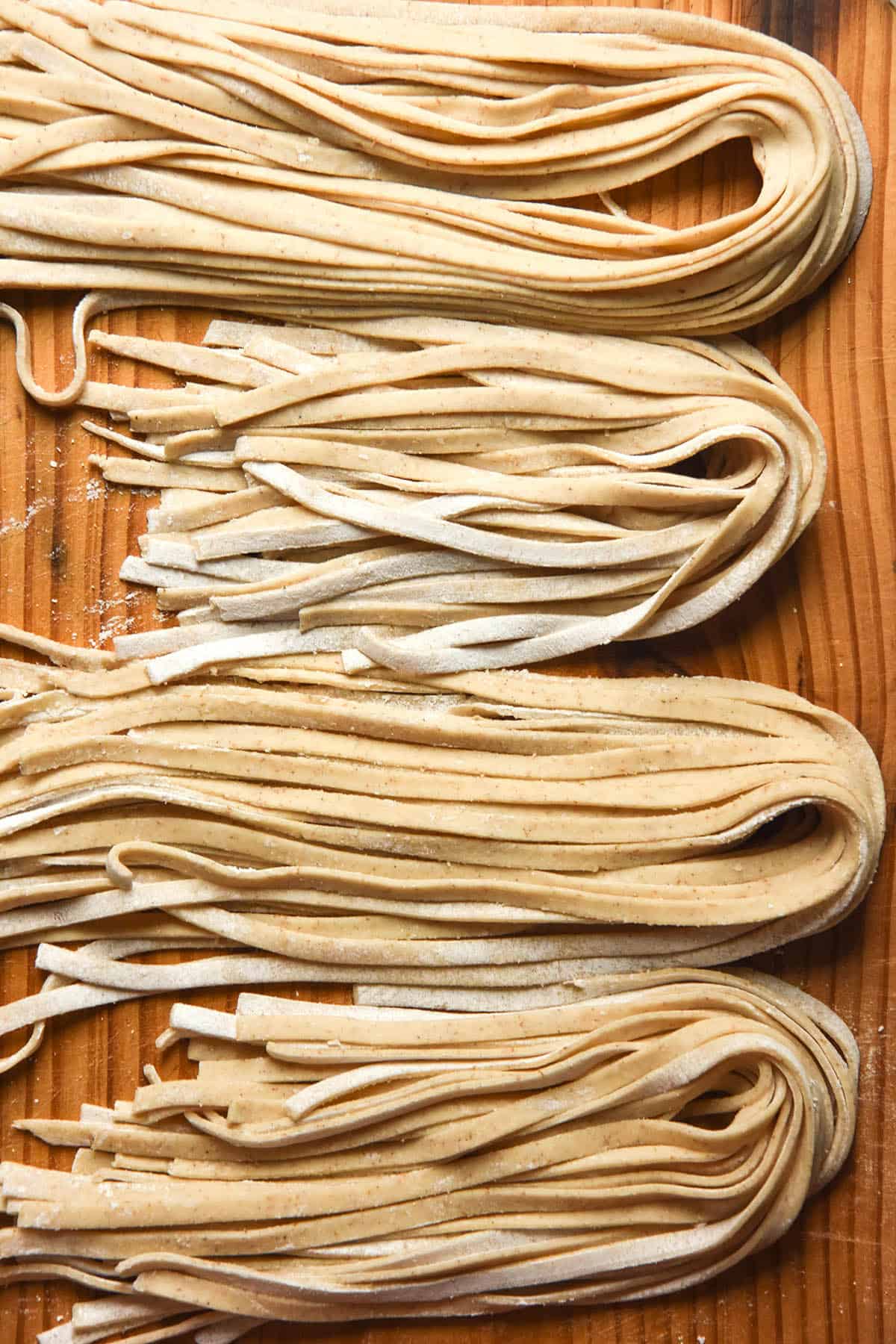
Ingredient notes for your gluten free egg pasta without xanthan gum
I have tested this recipe with white rice flour and tapioca flour. This is the only combination I have tested thus far. The success of that recipe leads me to believe that you could experiment with the flours in this recipe.
Keep in mind, however, that different flours have varying absorbencies. If you use a flour with a lesser absorbency, you will need to adjust the liquid content to suit.
Psyllium husk powder is what I use almost exclusively these days. It is more absorbent than psyllium husk flakes and has less of an impact on aesthetics. It also doesn’t disrupt lamination (in things like croissants) or make things hard to slice (in things like this pasta).
On the note of psyllium husk powder: store bought powder has a tendency to turn things grey. For this reason, I like to buy the husks and grind them to a powder in a spice grinder.
Eggs are an integral part of this recipe and can’t be omitted. I have some egg free noodle and pasta recipes that you can find on my site.
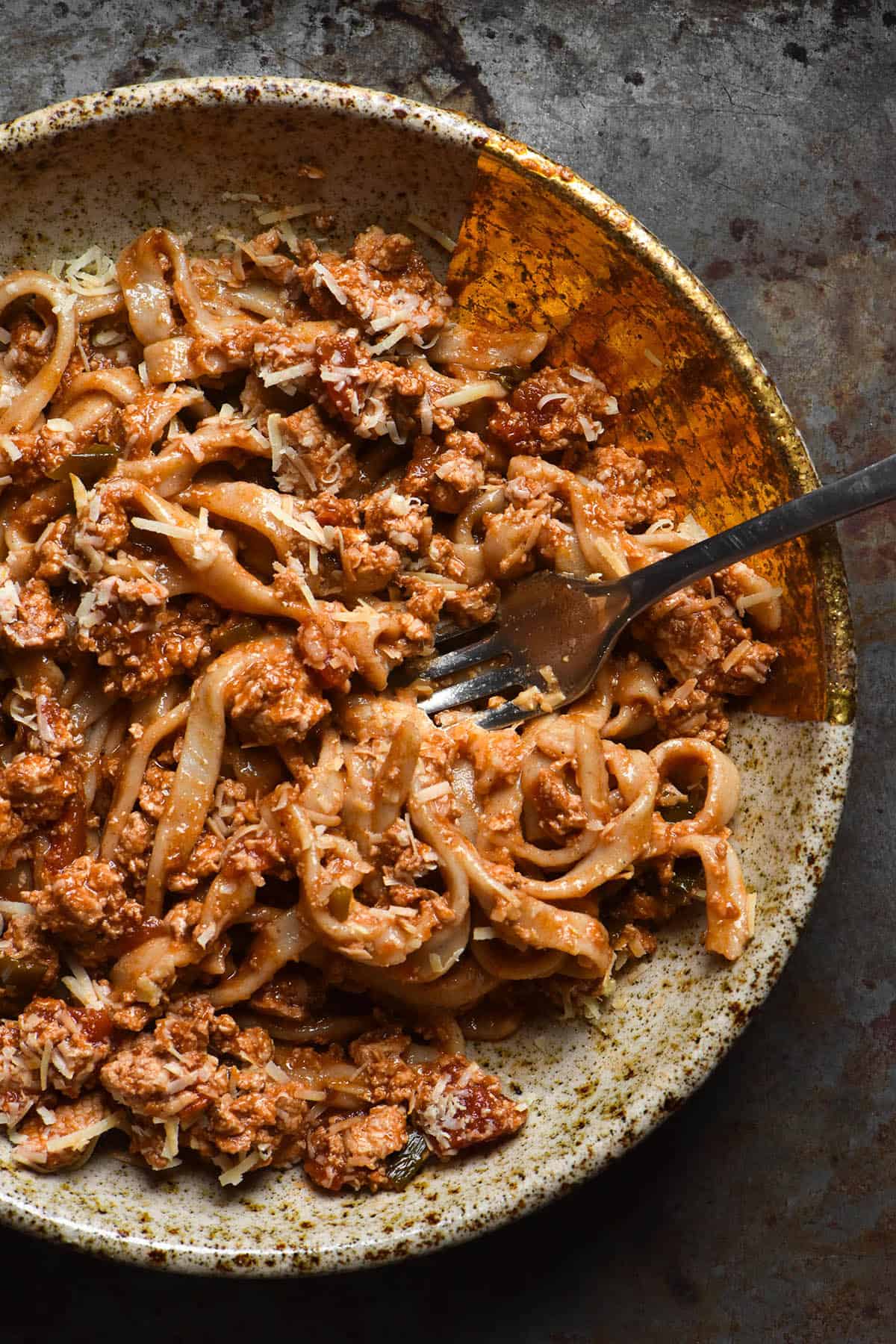
Tips for your gluten free pasta dough
Firstly, remember that every bag of flour has a different level of absorbency. The flours I tested might be more or less absorbent than the ones you have. You need to take some initiative in determining how much liquid is right for your pasta dough. That the consistency of your dough matches the consistency specified in the recipe is far more important than using the exact same amount of water than I did.
This leads me to my next point: the ideal consistency of this pasta dough is smooth and with no dry flour, but overall dry and stiff. The dough should never be so dry as to feel crumbly or easy to pull apart into crumbles. However, it should no be too wet that you can’t pick it up and easily roll it out (with some flour on the bench).
Stiff dough that forms a cohesive ball is the best and easiest pasta dough to roll out. You might think that a wetter pasta dough will be easier to roll out and require less elbow grease. However, that momentary ease dissipates once you have to start feeding a wet dough through a pasta machine.
Tips for rolling out your gluten free pasta without xanthan gum
This dough, if made with the right hydration, is really flexible and easy enough to roll out. It does take a little bit of elbow grease, as any good pasta dough does. However, there are a few tips and tricks to make your best pasta possible.
Firstly, always make sure you have plenty of tapioca flour on hand for rolling out the dough. Tapioca flour is inexpensive, easy to buy and has a lovely soft texture. It is great for course-correcting an overly wet dough and for lessening the chance pasta will stick. It also doesn’t add any grit to the pasta as other flours might.
Secondly, I like to roll my pasta to my desired thickness by hand. This is optional, but I find that it’s best to put gluten free pasta through the machine as few times as possible. Gluten free pasta is prone to breakage so this minimises the amount of breakage risk.
When choosing your desired thickness, keep in mind that the pasta will expand considerably as it cooks. Roll the dough thinner than you want your pasta to end up. The dough can easily be rolled thinly with tapioca flour and a bit of patience.
One last tip: slightly shorter pasta noodles are less likely to break. If you keep having trouble with pasta breakage, make the pasta sheets and subsequent pasta noodles a bit shorter.
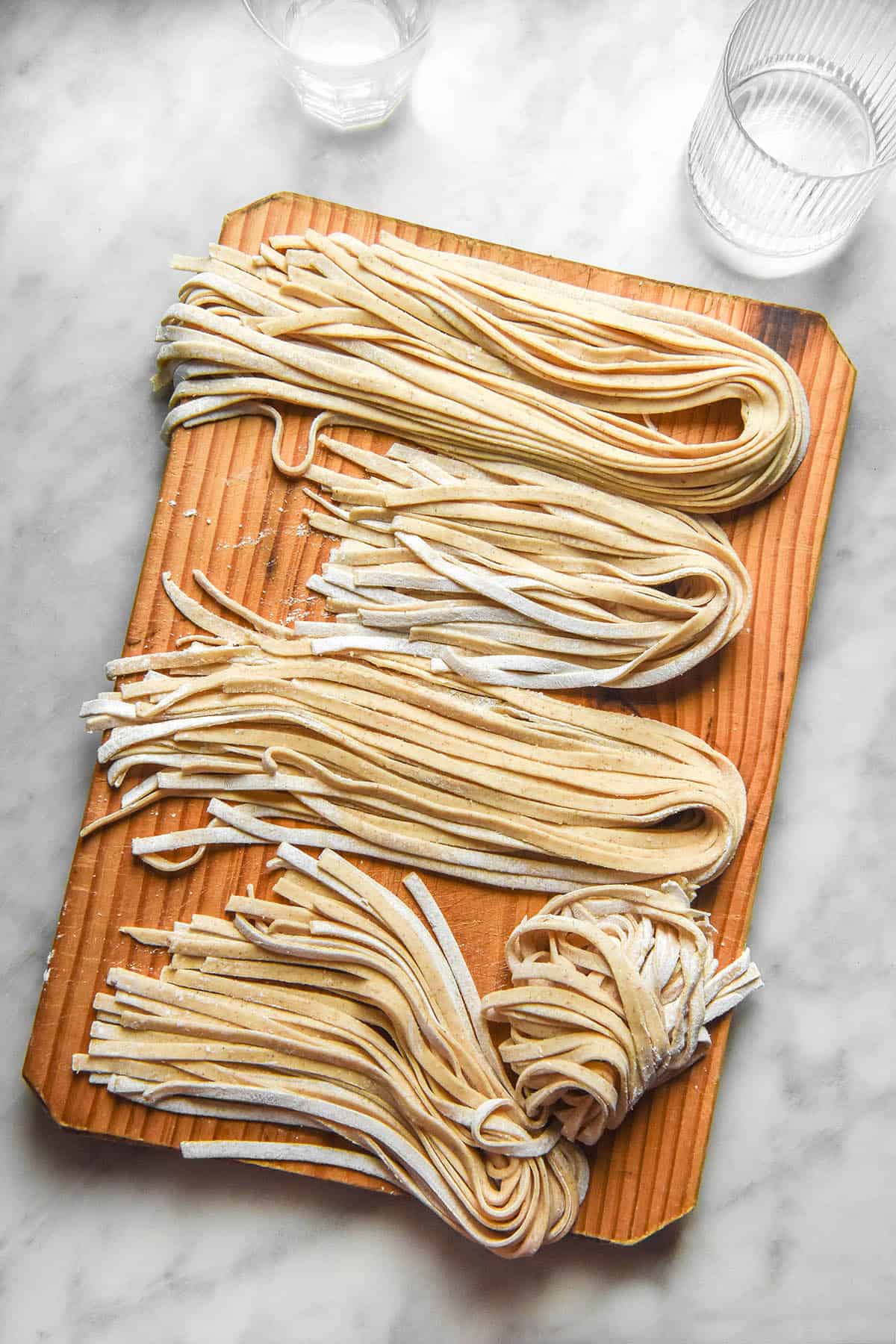
Do I need a pasta machine for this recipe?
I haven’t tried making this pasta without a machine and I have no intention of trying. Is it possible? Maybe. Is it worth the time? I say no.
Personally, I think the fun of making your own egg pasta is in the rolling out of the dough. I don’t think it tastes infinitely better than regular pasta? But the experience of rolling it out by hand is what makes it special.
Without a pasta machine, you’re taking away the fun bit. Cutting pasta by hand is tedious and cumbersome. What’s more, you are destined to have thicker and thinner parts of the pasta which will subsequently cook unevenly. Egg pasta swells as it cooks, compounding the issue.
If you intend to make pasta regularly, I highly recommend getting a pasta machine. I have a cheap one that is not good at all! But it still cuts the pasta and rolls the dough to an even width. They’re readily available at op shops these days, making them even cheaper.
Why is my pasta grey?
As discussed above, store bought psyllium husk powder has a tendency to turn things a purple/grey hue. It’s still completely safe to eat, but can be a bit of an aesthetic bummer.
I haven’t figured out exactly why this happens. It could be that they use a specific type of psyllium husk, as I recall Europeans on a gluten free bread forum complaining of this. It could also be that the husks oxidise while on the shelf. Either way, grind your own if the aesthetic is important to you and you know a brand of psyllium husk flakes that don’t go grey. I have found it can vary brand to brand, so shop around if yours keeps turning things grey.
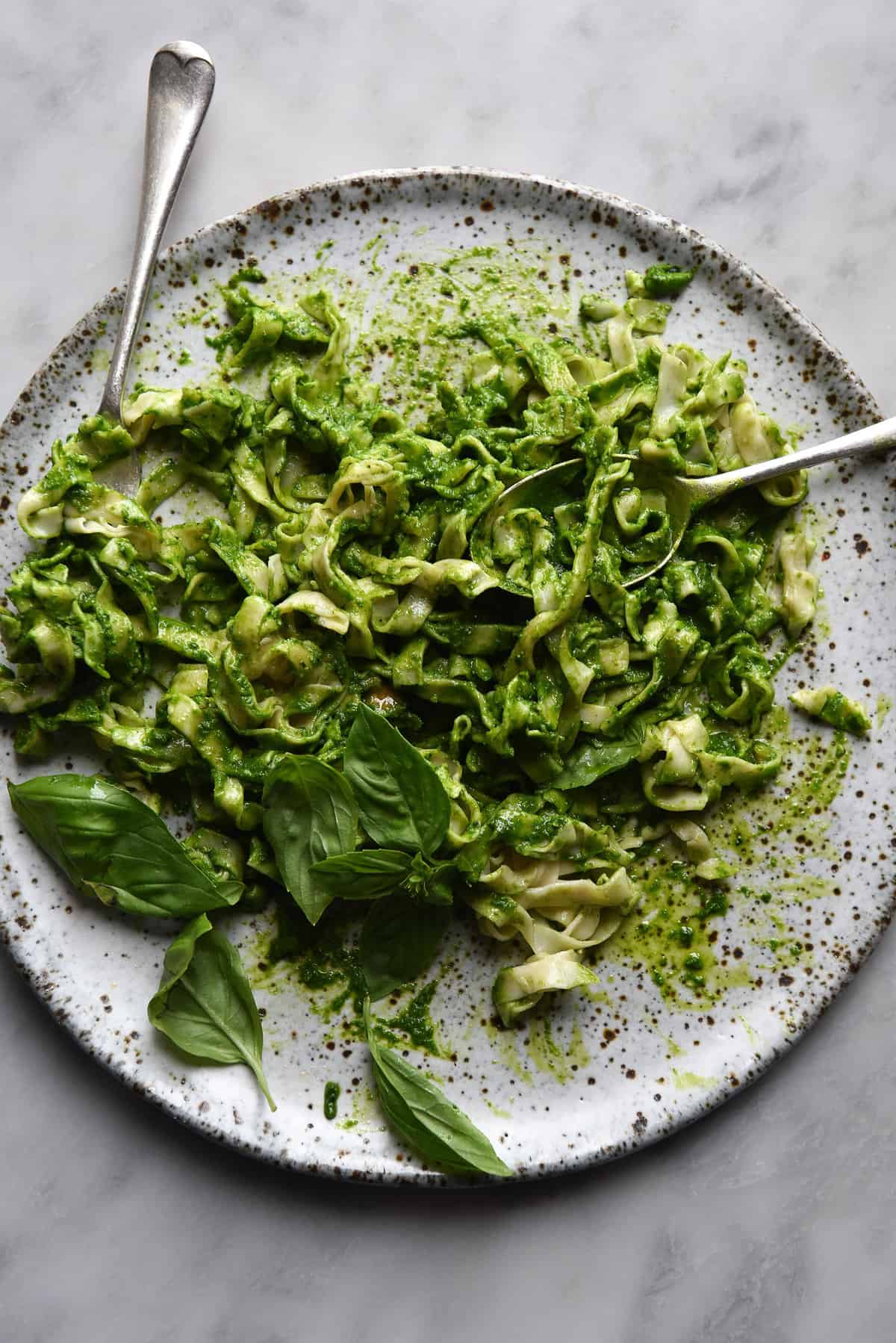
Is this pasta as strong as pasta with xanthan gum?
No, it isn’t. With that said, it’s still a hell of a lot stronger than you’d expect a gluten free pasta without xanthan gum to be. Some tips for keeping it in nice long strands:
- Be gentle with it once cut! It’s gluten free, xanthan gum free pasta.
- Keep the cooking water at a simmer rather than a strong boil. This ensures the pasta isn’t being swooshed around too much while it cooks.
- When you drain the pasta, try not to dump it into the sieve. Decant it from the pot gently, and don’t pour a wave of boiling water straight on top of it.
- Once cooked, I recommend giving it a quick rinse. It will feel sticky immediately after cooking and rinsing some of the excess starch off helps here.
- To keep it nice and supple (and not stuck to other pieces) I recommend adding the sauce immediately after cooking.
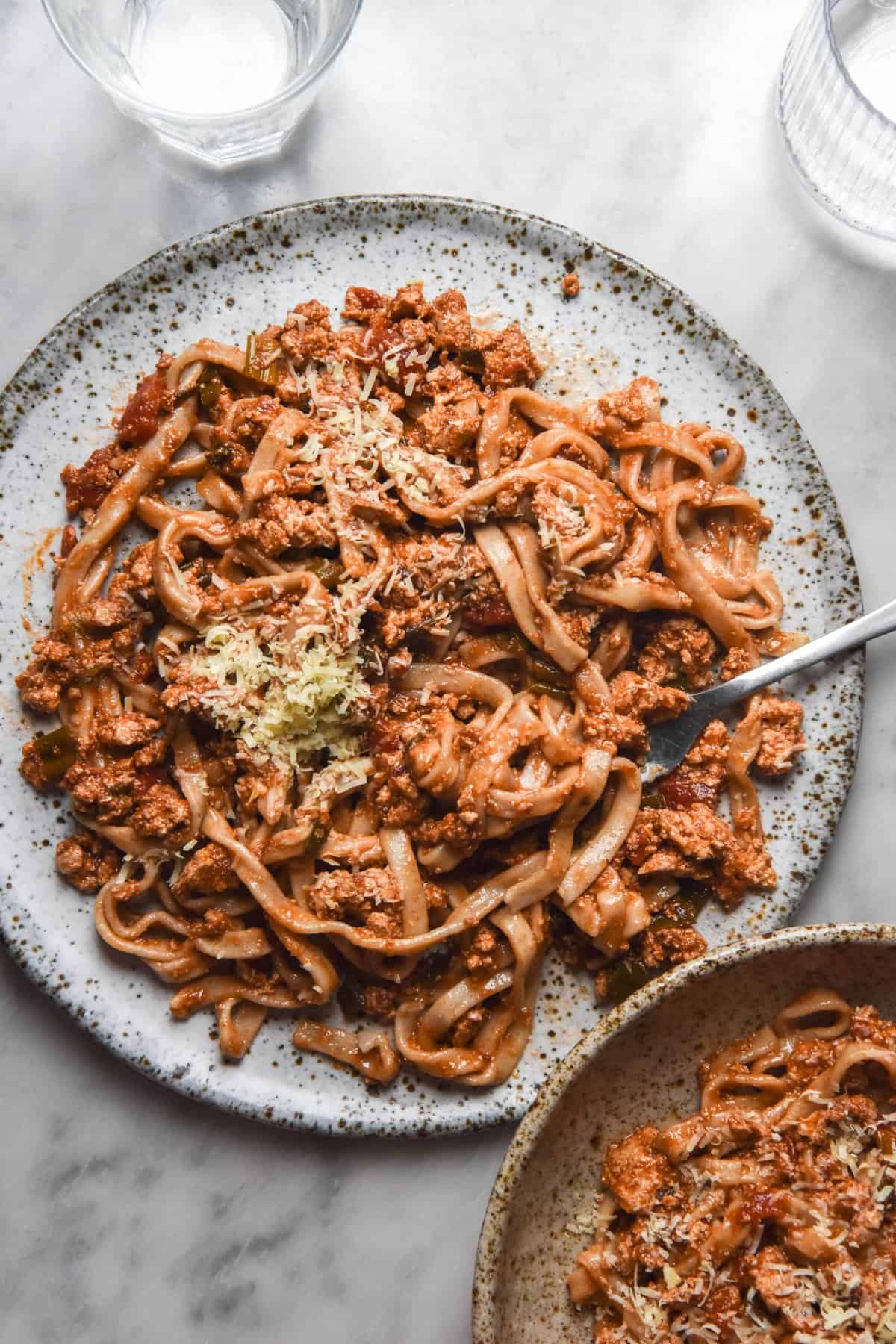
What can I serve with this gluten free egg pasta?
I have a few low FODMAP pasta sauce recipes that I love and use regularly. Without further ado:
- Low FODMAP tomato mascarpone pasta sauce
- Low FODMAP vegan bolognese
- Easy everyday low FODMAP pasta sauce (a parmesan, chilli, infused garlic oil and sundried tomato sauce)
- Low FODMAP pumpkin pasta
- Low FODMAP tomato pasta sauce
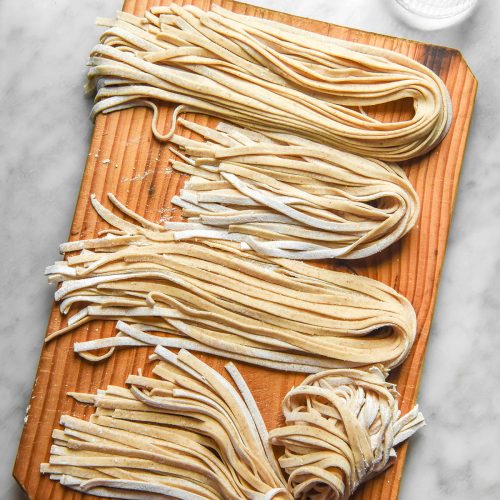
Gluten free egg pasta without xanthan gum
Ingredients
- 300 g fine white rice flour
- 75 g tapioca flour
- 20 g psyllium husk powder
- 150 g boiling water
- 3 extra-large eggs 45-55g per egg, weighed out of shell
- Plenty of extra tapioca flour for rolling out the pasta
Instructions
To make the dough:
- Combine the dry ingredients in a large mixing bowl. Pour over the boiling water, then set aside for 20 minutes for the dough to cool.
- Once sufficiently cooled, mix in the eggs. Stir the dough as much as you can, then tip it out onto a clean dry bench. There will likely be lots of dry bits and errant flour. Continue to knead the dough until it comes together in a smooth ball with no dry flour bits.
- The dough should be smooth with no dry bits, but it should still be a stiff dough. It shouldn’t feel crumbly or like it could easily crumble in your hands, but it also shouldn’t feel wet.
- If it isn’t the right texture, make amendments (add a small amount of water or flour until you reach the described consistency).
- Liberally flour your bench with tapioca flour and divide the dough in 4 or 5 equal sized balls. Cover all but one.
- Use a rolling pin to roll the dough out into a long rectangle, thin enough to thread through the pasta machine. Trim the scraggly edges to ensure the rectangles are easy to put through your pasta machine. The pasta expands during cooking, so roll the dough thinner than you'd like your pasta.
- Cut your sheets by carefully feeding them through the fettuccine style cutter for thicker pasta noodles. Assemble each group of cut pasta in small nests on the bench or a clean, dry board. You can gather up and scrappy bits and roll them into the next ball of dough. Continue until all the noodles have been cut.
- You can restore scraggly bits by kneading in small splashes of water until you reach the desired consistency.
To cook the noodles:
- Bring a medium or large pot of well salted water to a gentle boil. A gentle boil ensures the pasta is less likely to break as it cooks.
- Cook the noodles in batches (I recommend max 3 nests at a time) for 3-5 minutes. The thicker you make your pasta, the longer it will take to cook. Once cooked, very gently remove from the water and place into a strainer over the sink.
- Drizzle each batch of cooked noodles with a small amount of oil (I use olive) to ensure they don’t stick together as they cool. I also like to gently rinse them of any excess starch before I oil them, but this is optional. Top with your preferred sauce and serve.
- Leftovers store well in the fridge for a few days. Uncooked noodles can be frozen in nests. Simply cook them straight from the freezer and allow a minute or two extra for them to cook through. Gently unfurl them with a fork or tongs as they cook.
Notes
- The body of the post contains a multitude of tips and tricks to ensure your success.

Georgia, this recipe is genius! I am in awe of how well the pasta dough holds up through multiple passes in the pasta machine. I am thinking tortellini or ravioli next. Thank you so much for sharing.
just to clarify: once the dry ingredients are mixed, the boiling water is poured over them and NOT stirred? just letting it sit for 20 min?thank you
You can stir it a bit if you like, but I generally just pour the water over evenly as opposed to in one spot.
Either way it doesn’t make a critical difference as we are still adding eggs and kneading after the dough has cooled 🙂
got it thank you so much
I am excited to make raviolis
what if I substitute flax meal powder instead of psyllium husk powder ?
Hi Alessa! I have never tested this and I have no experience working with flax powder as a binder so I can’t offer any advice sorry!
Thanks for responding Georgia, if I try this out and I’ll let you know what happens !
Love your site, tried to subscribe a couple of times but didn’t get though…
Once I make the pasta, am I able to dry it on my dehydrator and store it at room temperature in an air tight container or does it have to be frozen?
Hi Cat! I haven’t tested the theory unfortunately. My only concern is that it might somehow make the psyllium husk more brittle and prone to snapping, but that is just a maybe.
Let me know how it goes if you do decide to try it!